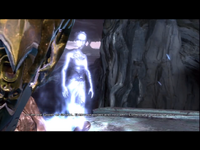No edit summary Tag: Visual edit |
|||
| (9 intermediate revisions by 6 users not shown) | |||
| Line 1: | Line 1: | ||
| − | [[File:Pandora.png|thumb|200px |
+ | [[File:Pandora.png|thumb|200px|Pandora speaking through her Statue to Kratos in God of War III.]] |
| + | '''Pandora Statues''' were objects in [[God of War III]]. They were attempts by [[Hephaestus]] to recreate his beloved "daughter", [[Pandora]], who was taken from him by [[Zeus]]. Although the statues were magnificently detailed, and looked exactly like the real thing, they were all inanimate, as Hephaestus no longer had access to the [[Flame of Olympus]] which gave the original life. Somehow, Pandora could speak through them at will. |
||
| − | Throughout the God of War series, statues are often used to communicate with Kratos, as some sort of out-of-body appearance. |
||
| ⚫ | |||
| − | + | Throughout his quest, [[Kratos]] encountered many statues of Pandora, through which she communicated with him and guided him to her location. They were quite similar to [[Athena]]'s [[Statue of Athena|Statues]] in the previous games. However, the mode of communication differed-Pandora manifested herself as a ghost-like image within the blue flame that was held by her statues, while Athena appeared as a living statue of herself. |
|
| − | Kratos |
+ | Kratos encountered five of those statues in total; three in the [[Underworld]], with one of them impaled by the [[Blade of Olympus]], one in the secret passageway to the [[Chain of Balance]], and a final one in [[Poseidon's Chamber (God of War III)|Poseidon's Chamber]]. Dozens more were visible in [[Hephaestus]]' Forge, as he desperately attempted to recreate Pandora. |
| − | ==Related |
+ | ==Related Pages== |
*[[Pandora]] |
*[[Pandora]] |
||
| ⚫ | |||
| + | [[Category:Statues]] |
||
Revision as of 18:07, 27 September 2017

Pandora speaking through her Statue to Kratos in God of War III.
Pandora Statues were objects in God of War III. They were attempts by Hephaestus to recreate his beloved "daughter", Pandora, who was taken from him by Zeus. Although the statues were magnificently detailed, and looked exactly like the real thing, they were all inanimate, as Hephaestus no longer had access to the Flame of Olympus which gave the original life. Somehow, Pandora could speak through them at will.
Throughout his quest, Kratos encountered many statues of Pandora, through which she communicated with him and guided him to her location. They were quite similar to Athena's Statues in the previous games. However, the mode of communication differed-Pandora manifested herself as a ghost-like image within the blue flame that was held by her statues, while Athena appeared as a living statue of herself.
Kratos encountered five of those statues in total; three in the Underworld, with one of them impaled by the Blade of Olympus, one in the secret passageway to the Chain of Balance, and a final one in Poseidon's Chamber. Dozens more were visible in Hephaestus' Forge, as he desperately attempted to recreate Pandora.
